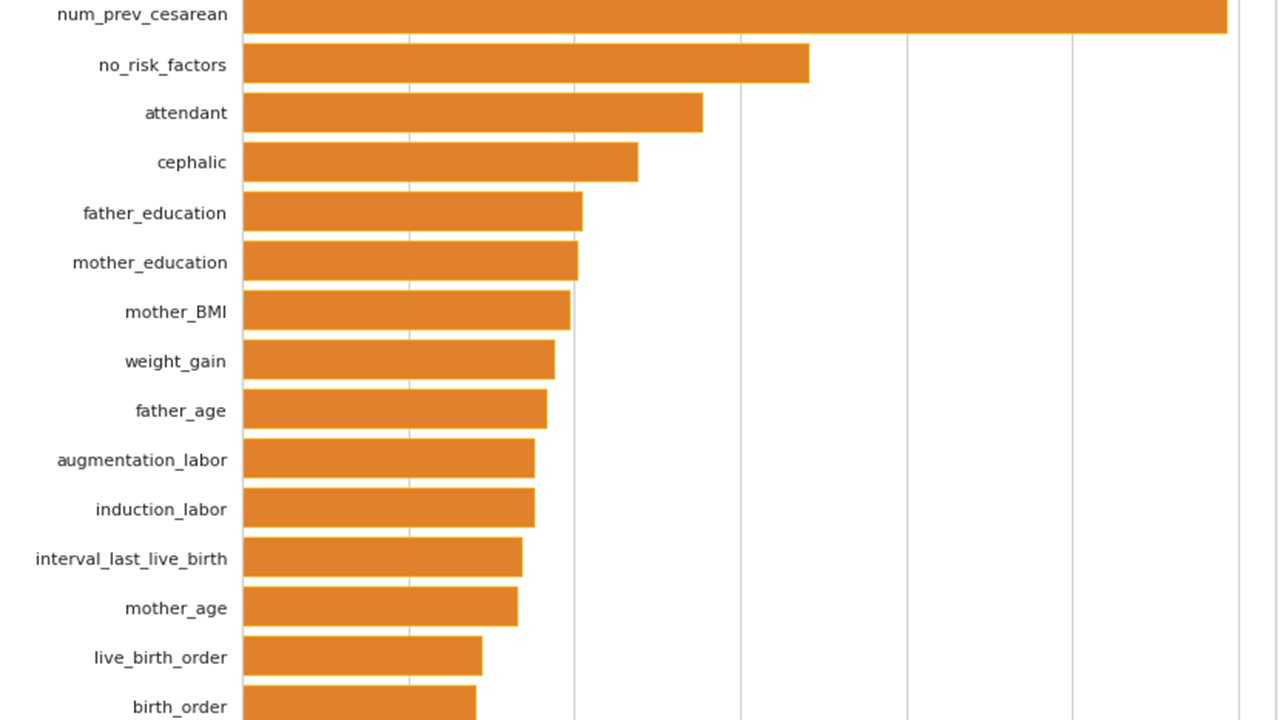Determinants and prediction of cesarean delivery using machine learning techniques
Keywords:
Machine learning, classification, prediction model, cesarean delivery, decision makingAbstract
Evidences that performing cesarean deliveries is guided worldwide by socioeconomic factors and that this practice can increase risks to maternal and child health imposes a global discussion on the proper use of cesarean sections. The aim of this study is to contribute to this discussion through: (i) identification of the most important factors for determining cesarean deliveries in the United States in 2019; and (ii) development of a model to predict the mode of delivery for prenatal care. The predictive performances of the algorithms Random Forest and k-Nearest Neighbors were tested on subsets of the National Center for Health Statistics data. The determinants of cesarean delivery were studied using logistic regression using features selected by Random Forest. The analysis of the results showed, for instance, that the intervention of labor augmentation, the cephalic presentation of the fetus, the number of previous live births, and the assistance of a nurse or midwife reduce the probability of a cesarean delivery; whereas higher maternal age groups (from 35 years old), twin births, maternal obesity, and previous cesarean sections increase the chance of the delivery being a cesarean section. The results reinforce the literature for the American case. Among the main contributions of this study to the literature is the economic focus, guiding machine learning techniques and algorithms in support of the global discussion on the appropriate use of cesarean sections.
References
ABBAS, S. A.; REHMAN, A. U.; MAJEED, F.; MAJID, A.; MALIK, M. S. A.; KAZMI, Z. H.; ZAFAR, S. Performance analysis of classification algorithms on birth dataset. IEEE Access, v.8, p.102146–102154, 2020.
ALAM, M. S. B.; PATWARY, M. J. A.; HASSAN, M. Birth mode prediction using bagging ensemble classifier: A case study of Bangladesh. Em: 2021 International Conference on Information and Communication Technology for Sustainable Development (ICICT4SD). 2021. p.95–99.
BALDI, P.; BRUNAK, S.; CHAUVIN, Y.; ANDERSEN, C. A. F.; NIELSEN, H. Assessing the accuracy of prediction algorithms for classification: an overview. Bioinformatics, v.16, p.412–424, 2000.
DESYANI, T.; SAIFUDIN, A.; YULIANTI, Y. Feature selection based on Naive Bayes for caesarean section prediction. IOP Conference Series: Materials Science and Engineering, v.879, p.012091, 2020.
FACELI, K.; LORENA, A. C.; GAMA, J.; de ALMEIDA, T. A.; de LEON FERREIRA DE CARVALHO, A. C. P. Inteligência artificial: uma abordagem de aprendizado de máquina. 2a ed. Grupo Gen – LTC. 2021.
ISLAM, M. N.; MAHMUD, T.; KHAN, N. I.; MUSTAFINA, S. N.; ISLAM, A. K. M. N. Exploring machine learning algorithms to find the best features for predicting modes of childbirth. IEEE Access, v.9, p.1680–1692, 2021.
KAVITHA, D.; BALASUBRAMANIAN, T. A comparative study on mode of delivery and analyzing the risk factors of cesarean delivery using k-nearest neighbor, SVM and C5.0 classification techniques. Turkish Journal of Physiotherapy and Rehabilitation, v.32, n.2, p.1873–1878, 2021.
KOWSHER, M.; PROTTASHA, N. J.; TAHABILDER, A.; ISLAM, M. B. Machine learning based recommendation systems for the mode of childbirth. Em: Bhuiyan, T., Rahman, M. M., Ali, M. A. (Eds) Cyber Security and Computer Science. Cham: Springer International Publishing. 2020. p.295–306.
LEMAÎTRE, G.; NOGUEIRA, F.; ARIDAS, C. K. Imbalanced-learn: A Python toolbox to tackle the curse of imbalanced datasets in machine learning. Journal of Machine Learning Research, v.18, n.2017, p.1–5, 2017.
NCHS. Natality 2019. URL http://www.cdc.gov/nchs/data_access/VitalStatsOnline.htm.2020.
PAULA, G. A. Modelos de regressão: com apoio computacional. URL https://www.ime.usp.br/~giapaula/texto_2023.pdf. 2023.
PEDREGOSA, F.; VAROQUAUX, G.; GRAMFORT, A.; MICHEL, V.; THIRION, B.; GRISEL, O.; BLONDEL, M.; PRETTENHOFER, P.; WEISS, R.; DUBOURG, V.; VANDERPLAS, J.; PASSOS, A.; COURNAPEAU, D.; BRUCHER, M.; PERROT, M.; DUCHESNAY, E. Scikit-learn: Machine learning in Python. Journal of Machine Learning Research, v.12, n.2021, p.2825–2830, 2011.
RAHMAN, S.; KHAN, M. I.; SATU, M. S.; ABEDIN, M. Z. Risk Prediction with Machine Learning in Cesarean Section: Optimizing Healthcare Operational Decisions. Cham: Springer International Publishing. 2021. p.293–314.
SANTOS, T. T. Evidências de indução de demanda por parto cesáreo no Brasil. Dissertação de Mestrado em Economia, Universidade Federal de Minas Gerais. 2011.
SEABOLD, S.; PERKTOLD, J. statsmodels: Econometric and statistical modeling with Python. Em: 9th Python in Science Conference. 2010.
ULLAH, Z.; SALEEM, F.; JAMJOOM, M.; FAKIEH, B. Reliable prediction models based on enriched data for identifying the mode of childbirth by using machine learning methods: Development study. Journal of Medical Internet Research, v.23, n.6, e28856, 2021.
WHO. WHO statement on caesarean section rates. URL https://www.who.int/publications/i/item/WHO-RHR-15.02. 2015.

Downloads
Published
How to Cite
Issue
Section
License
Proposta de Política para Periódicos de Acesso Livre
Autores que publicam nesta revista concordam com os seguintes termos:
- Autores mantém os direitos autorais e concedem à revista o direito de primeira publicação, com o trabalho simultaneamente licenciado sob a Licença Creative Commons Attribution que permite o compartilhamento do trabalho com reconhecimento da autoria e publicação inicial nesta revista.
- Autores têm autorização para assumir contratos adicionais separadamente, para distribuição não-exclusiva da versão do trabalho publicada nesta revista (ex.: publicar em repositório institucional ou como capítulo de livro), com reconhecimento de autoria e publicação inicial nesta revista.
- Autores têm permissão e são estimulados a publicar e distribuir seu trabalho online (ex.: em repositórios institucionais ou na sua página pessoal) a qualquer ponto antes ou durante o processo editorial, já que isso pode gerar alterações produtivas, bem como aumentar o impacto e a citação do trabalho publicado (Veja O Efeito do Acesso Livre).
